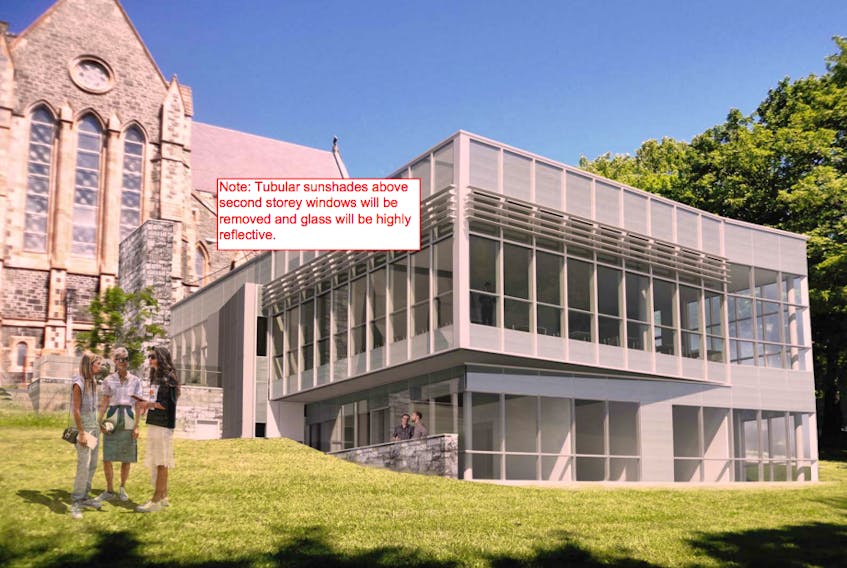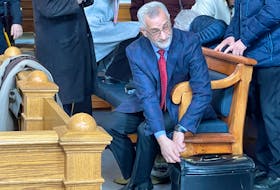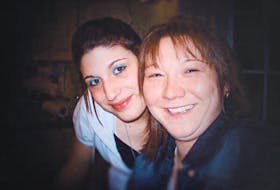ST. JOHN'S, N.L. — It’s been a trying week for Archdeacon Roger Whalen with the Anglican Cathedral of St. John the Baptist.
As he spoke with The Telegram on the phone, his voice sounded hoarse and tired.
He’s been dealing with controversy surrounding a proposed annex to be built next to the historic cathedral to house a new, accessible parish hall, as well as offices, a public café and space to do community outreach work.
Controversy surrounding the proposed annex stems mainly from concerns over disturbing the burial ground, but also includes concerns about the proposed building’s modern design juxtaposed with the renowned gothic revival architecture of the cathedral, a St. John’s designated heritage building.
Whalen is set to meet with members of city council to answer questions about the annex on Tuesday.
Council had deferred a decision of whether or not to approve the annex on July 8, but it’s expected to be voted on again at the next meeting of council on July 22, according to a city spokesperson.
Thousands buried in church yard

In the interim, a retired Memorial University history professor called into question the church’s morals.
“They’re building it on top of what I think to be one of the largest, if not the largest, pre-Confederation cemetery of working people in British North America,” he said.
Robert Sweeny estimated there’s anywhere between 10,000 to 20,000 people buried in the hill that extends from the cathedral down to a stone retaining wall along Duckworth Street.
“This is the last resting place for thousands of working people who left their homes in the West Country of England to work here in the hope of going back home, and establishing a family and buying some land. ...I don’t think I’m alone, and I don’t think it’s necessarily religious of me, to think that the final resting place of thousands of people deserves our respect.”
Church records indicate a much lower number of burials — closer to the long-held estimate of 5,000.
“I don’t where he dug up his facts,” said Whalen.
According to Blair Temple, the archeologist who oversaw test digs for the proposed annex, the first known ecclesiastic structure built in the area of the current cathedral was a church constructed in 1720.
While the Parish of St. John the Baptist was formed in 1699, the associated churches — there were several built because they were destroyed during French attacks — were built at Fort William near the present-day Sheraton Hotel Newfoundland, roughly a kilometre away from the cathedral.
An anonymous map of 1743, showing an upside-down T-shaped structure to the centre of the present-day property is surrounded by grave-like features, indicating burials predate parish burial records beginning in 1752.
Temple said the burial records indicate about 4,600 people were buried in the churchyard, but there were some missing years, so he averaged out the years before and after those missing ones to get a rough idea of how many people would have been buried.
In total, he estimates there are around 5,500 to 5,600 people buried in the church yard.
“The church was constructed in 1720 and, basically, before that there really isn’t any full understanding of what the property was used for — that’s my understanding right now,” said Temple.
“Where people would have been buried, say, during the late 17th century, I have absolutely no idea. There’s got to be a burial ground somewhere. I mean, maybe they were buried in this one, I don’t know, but that gets back to my point that we don’t know — we really don’t know. But there could be another burial ground, a 17th century burial ground in the city somewhere. Where to? Who knows. No idea.”
Of morality, spirituality, and the law
Whether there’s 5,600 people buried under the hill, or 20,000 as the retired professor estimated, Sweeny said he thinks the church has lost its moral compass.
“All of these anonymous working men — overwhelmingly men — who are buried there, along with the general population of the town, don’t merit our respect? Don’t merit public history? Aren’t part of our past? Don’t have anything to say to us? I think they do, I’m sorry.”
He said our connection to the past is being lost all the time in public decision-making.
When asked about the religious viewpoint of building over old burial grounds, Whalen said the soul no longer resides in the body.
“The soul moves on to the next life, the next existence — that being, for us Christians, eternal life with God. So, the body, then, is just a shell.”
Under municipal and provincial regulations, the church is allowed to build over the cemetery provided it obtains the required permits.
According to a spokesperson with the Department of Tourism, Culture, Industry and Innovation, the province considers the cemetery a historic resource under the Historic Resources Act.
The annex is proposed to be built over a part of the church yard, so the Act requires an impact assessment to determine the effect of the construction on the historic resource.
“All of these anonymous working men — overwhelmingly men — who are buried there, along with the general population of the town, don’t merit our respect? Don’t merit public history? Aren’t part of our past? Don’t have anything to say to us? I think they do, I’m sorry.” — Robert Sweeney, retired MUN history professor
The spokesperson said the Exhumation Act also applies to the excavation of cemeteries.
The Act dictates a body or remains cannot be removed from the place of burial except under licence signed by the minister of justice or chief medical examiner. If someone were to remove remains without a licence, they could face a summary conviction - a fine of no more than $50.
As for city regulations, permits are required for all excavations, including for foundations.
Archdeacon Whalen said they have obtained all required permits for the preliminary work they’ve done so far, such as digging the test pits.
“We did it very carefully, and we found nothing but rubble from the fire of 1892,” he said.
“We did our homework. We checked it out, we followed the records, we went for the permitting, we did some excavating, and this is where we are. We haven’t found anything, and so then we decided, yes, OK, we can move forward because according to all of the work that we’ve done, there’s nothing there in that area.”
Whalen said if they do find the full remains of people during the construction then they would “reevaluate the situation”.
If they do happen to dig up bones, it wouldn’t be the first time the old burial ground was disturbed.
In 1999, an oil leak from the cathedral heating system’s underground tank meant the area had to be excavated to remove the wasted fuel. Bones found during the cleanup were reburied in the yard and their reinternment was accompanied with a prayer service.
And if the annex were to be built over graves, it wouldn’t be the first time a cemetery was covered. A Catholic cemetery on Long’s Hill is now a parking lot.
According to an article about Newfoundland cemeteries by folklorist Gerald Pocius in the Material Culture Review in 1986, “today many early cemeteries have been built over and are largely forgotten.”
Twitter: @juanitamercer_









